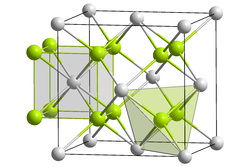Neptunium(IV) oxide

| |

| |
| Names | |
|---|---|
| IUPAC name
Neptunium(IV) oxide
| |
| Other names
Neptunium oxide, neptunium dioxide
| |
| Identifiers | |
3D model (
JSmol ) |
|
| ChemSpider | |
ECHA InfoCard
|
100.031.651 |
| EC Number |
|
PubChem CID
|
|
| |
| |
| Properties | |
| NpO2 | |
| Molar mass | 269 g/mol |
| Appearance | Green cubic crystals |
| Density | 11.1 g/cm3 |
| Melting point | 2,800 °C; 5,070 °F; 3,070 K[1] |
| Structure[2] | |
| Flourite (cubic), cF12 | |
| Fm3m, #225 | |
a = 543.4 pm
| |
Formula units (Z)
|
4 |
| Thermochemistry | |
Std molar
entropy (S⦵298) |
19.19 ± 0.1 cal·mol−1·K−1 (80.3 ± 0.4 J·mol−1·K−1)[3] |
Std enthalpy of (ΔfH⦵298)formation |
−256.7 ± 0.6 kcal·mol−1 (−1074 ± 3 kJ·mol−1)[4] |
| Related compounds | |
Other anions
|
Neptunium(III) chloride Neptunium(IV) chloride |
Other cations
|
Americium(IV) oxide
|
Except where otherwise noted, data are given for materials in their standard state (at 25 °C [77 °F], 100 kPa).
| |
Neptunium(IV) oxide, or neptunium dioxide, is a
Production
Industrially, neptunium dioxide is formed by precipitation of neptunium(IV) oxalate, followed by calcination to neptunium dioxide.[7]
Production starts with a
- 2Np5+ + C6H8O6 → 2Np4+ + C6H6O6 + 2H+
- Np6+ + C6H8O6 → Np4+ + C6H6O6 + 2H+
Addition of oxalic acid precipitates hydrated neptunium oxalate...
- Np4+ + 2H2C2O4 + 6H2O → Np(C2O4)2.6H2O(v) + 4H+
...which pyrolyzes when heated:[7]
- Np(C2O4)2.6H2O Δ
→ Np(C2O4)2 Δ
→ NpO2 + 2CO(g)
Neptunium dioxide can also be formed from precipitation of neptunium(IV) peroxide, but the process is much more sensitive.[7]
Purification
As a byproduct of nuclear fission reactors, neptunium dioxide can be purified by
Other properties
Neptunium dioxide contributes to the α-decay of 241Am, reducing its usual half-life an untested but appreciable amount.[8] The compound has a low specific heat capacity (900 K, compared with uranium dioxide's specific heat capacity of 1400 K), an abnormality theorized to stem from its 5f electron count.[9] Another unique trait of neptunium dioxide is its "mysterious low-temperature ordered phase". Mentioned above, it references an abnormal level of order for an actinitde dioxide complex at low temperature.[10] Further discussion of such topics could indicate useful physical trends in the actinoides.
Uses
The neptunium dioxide complex is used as a means of stabilizing, and decreasing the "long term environmental burden"[11] of neptunium as a nuclear fission byproduct. Actinoide-containing spent nuclear fuel will commonly be treated so that various AnO2 (where An = U, Np, Pu, Am, etc.) complexes form. In neptunium dioxide, neptunium is of reduced radio toxicity compared with elemental neptunium and is thus more desirable for storage and disposal. Neptunium dioxide has also been shown to contribute to increased decay rates of radioactive elements, an application which is currently being explored.[11]
Neptunium dioxide is also used experimentally for research into nuclear chemistry and physics, and it is speculated that it could be used to make efficient nuclear weapons. In nuclear reactors, neptunium dioxide can also be used as the target for plutonium bombardment.[11]
Furthermore, a patent for a rocket powered by neptunium dioxide is held by Shirakawa Toshihisa,[12] but there is little information available into research and production associated with such a product.
References
- ^ Böhler, R.; M. J. Welland; F. De Bruycker; K. Boboridis; A. Janssen; R. Eloirdi; R. J. M. Konings; D. Manara (2012). "Revisiting the melting temperature of NpO2 and the challenges associated with high temperature actinide compound measurements". Journal of Applied Physics. 111 (11). American Institute of Physics: 113501–113501–8. .
- S2CID 261051636.
- ^ Westrum, Jr., Edgar F.; J. B. Hatcher; Darrell W. Osborne (March 1953). "The Entropy and Low Temperature Heat Capacity of Neptunium Dioxide". Journal of Chemical Physics. 21 (3): 419. .
- ^ a b c Huber Jr, Elmer J.; Charles E. Holley Jr (October 1968). "Enthalpy of formation of neptunium dioxide". Journal of Chemical & Engineering Data. 13 (4): 545–546. .
- ISBN 0-07-049439-8.
- ISBN 0-8493-0594-2.
- ^ . Equations extrapolated from verbal description.
- .
- .
- S2CID 119295656.
- ^ .
- ^ Toshihisa, Shirakawa. "Bibliographic data: JP2007040768 (A) - 2007-02-15". Espacenet, patent search. Retrieved 11 April 2012.
